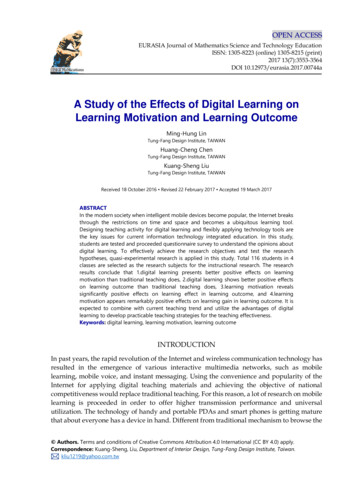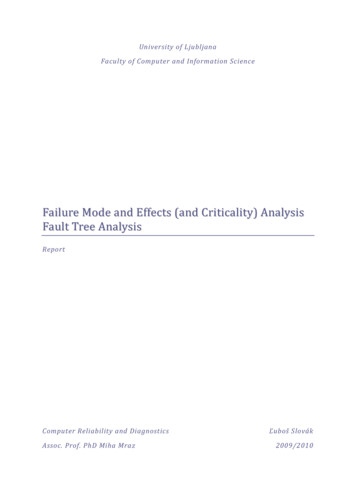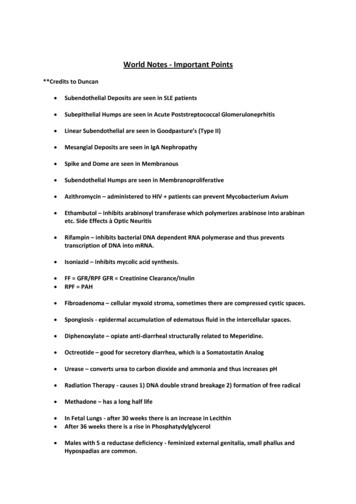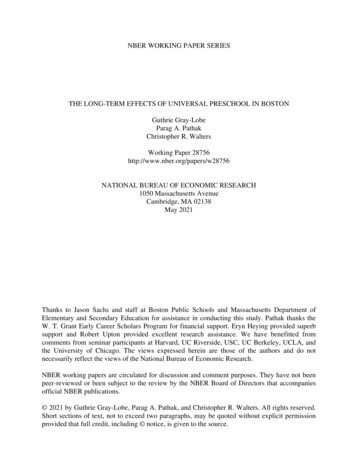
Transcription
OPEN ACCESSEURASIA Journal of Mathematics Science and Technology EducationISSN: 1305-8223 (online) 1305-8215 (print)2017 13(7):3553-3564DOI 10.12973/eurasia.2017.00744aA Study of the Effects of Digital Learning onLearning Motivation and Learning OutcomeMing-Hung LinTung-Fang Design Institute, TAIWANHuang-Cheng ChenTung-Fang Design Institute, TAIWANKuang-Sheng LiuTung-Fang Design Institute, TAIWANReceived 18 October 2016 Revised 22 February 2017 Accepted 19 March 2017ABSTRACTIn the modern society when intelligent mobile devices become popular, the Internet breaksthrough the restrictions on time and space and becomes a ubiquitous learning tool.Designing teaching activity for digital learning and flexibly applying technology tools arethe key issues for current information technology integrated education. In this study,students are tested and proceeded questionnaire survey to understand the opinions aboutdigital learning. To effectively achieve the research objectives and test the researchhypotheses, quasi-experimental research is applied in this study. Total 116 students in 4classes are selected as the research subjects for the instructional research. The researchresults conclude that 1.digital learning presents better positive effects on learningmotivation than traditional teaching does, 2.digital learning shows better positive effectson learning outcome than traditional teaching does, 3.learning motivation revealssignificantly positive effects on learning effect in learning outcome, and 4.learningmotivation appears remarkably positive effects on learning gain in learning outcome. It isexpected to combine with current teaching trend and utilize the advantages of digitallearning to develop practicable teaching strategies for the teaching effectiveness.Keywords: digital learning, learning motivation, learning outcomeINTRODUCTIONIn past years, the rapid revolution of the Internet and wireless communication technology hasresulted in the emergence of various interactive multimedia networks, such as mobilelearning, mobile voice, and instant messaging. Using the convenience and popularity of theInternet for applying digital teaching materials and achieving the objective of nationalcompetitiveness would replace traditional teaching. For this reason, a lot of research on mobilelearning is proceeded in order to offer higher transmission performance and universalutilization. The technology of handy and portable PDAs and smart phones is getting maturethat about everyone has a device in hand. Different from traditional mechanism to browse the Authors. Terms and conditions of Creative Commons Attribution 4.0 International (CC BY 4.0) apply.Correspondence: Kuang-Sheng, Liu, Department of Interior Design, Tung-Fang Design Institute, Taiwan.kliu1219@yahoo.com.tw
M.-H. Lin et al. / Digital Learning on Learning Motivation and Learning OutcomeState of the literature Computers and network technology media were applied to learning situations, includingsynchronous and asynchronous network learning, to break through the restrictions on time,location, and schedule.Diverse digital teaching materials are produced, and schools have actively introduced distinctdigital teaching platforms to the instruction, expecting to promote students’ learning outcome.In the era when knowledge and information flow rapidly, the application of digital learning coversdifferent fields and industries. Based on distinct positions or points of view, the definitions aredifferent.Contribution of this paper to the literature Teachers matching with the class teaching to make good use of teaching strategies, accordingto the class climate and create the learning situation for students being willing to use digitallearning so that students bravely propose questions in the discussion and increase the onlineinteractive learning with teachers.The key in developing the effectiveness of digital learning on teaching lies in teachers. Thepromotion of digital learning could provide alternative innovation of class teaching.The design of teaching activity and the flexible application of technology tools or digital learningtherefore become the primary issues for current information technology integrated education.Internet, a user could link to the server, through the network, to select proper digital teachingmaterials for the learning; and the instant tests allow students controlling the contents ofdigital teaching materials. Accordingly, practical teaching strategies could be developed bycombining with current teaching trend and extracting the advantages of digital learning toachieve the teaching effectiveness (Lai et al. 2012).Under the climate with changing learning modes, the government and businesses havelargely invested in the research and development of digital teaching platforms. The softwareand hardware for many digital teaching platforms have been developed, diverse digitalteaching materials are produced, and schools have actively introduced distinct digital teachingplatforms to the instruction, expecting to promote students’ learning outcome. Utilizing theshared education resources on the computer network for shortening the urban-rural educationgap has become a common trend globally. It is inevitable for teachers integrating informationtechnology into subjects to assist in students’ learning with teaching materials, teachingmethods, and diversified teaching media. It is the common responsibility for educators to haveteaching become more efficient, allow students being glad to learn, and cultivate the newgeneration with creative and rational communication and critical thinking with technologiesand network information in the new era. Digital teaching aims to have students activelyparticipate in learning activity to achieve the set learning outcome (Pai & Tu, 2011). The designof teaching activity and the flexible application of technology tools or digital learning thereforebecome the primary issues for current information technology integrated education.3554
EURASIA J Math Sci and Tech EdLITERATURE REVIEWDigital learningYoon et al. (2012) stated that digital learning (E-Learning) was first proposed by JayCross in 1999. With the advance and development of technology tools, it appeared differentexplanations and terminology, such as Internet-based training, web-based training, or on-linelearning, network learning, distance learning. Doris Holzberger et al. (2013) regarded digitallearning as delivery with digital forms of media (e.g. texts or pictures) through the Internet;and, the provided learning contents and teaching methods were to enhance learners’ learningand aimed to improve teaching effectiveness or promote personal knowledge and skills.Basically, computers and network technology media were applied to learning situations,including synchronous and asynchronous network learning, to break through the restrictionson time, location, and schedule, and to achieve the learner-centered individualized learning(Kaklamanou et al., 2012). In the era when knowledge and information flow rapidly, theapplication of digital learning covers different fields and industries. Based on distinct positionsor points of view, the definitions are different. The most representative one is the definitionproposed by American Society of Training and Education (ASTD). It defines e-learning as theprocess learners applying digital media to learning. Digital media contain the Internet,corporate network, computers, satellite broadcasting, audiotapes, videotapes, interactive TV,and compact disks. The application includes network-based learning, computer-basedlearning, virtual classrooms, and digital cooperation. Anttila et al. (2012) regarded digitallearning as a digital tool to acquire digital teaching materials for online or offline learningactivity through wire or wireless networks (Hockly, 2012).Current literatures therefore reveal different explanations of digital learning amongdomestic and international researchers. By comprehensively analyzing the viewpoints ofseveral researchers, digital learning could be divided into four parts (Keane, 2012).(1) Digital teaching materials: It emphasizes that learners could learn by extracting somedigital teaching material contents. The so-called digital teaching material contents refer toe-books, digitalized data, or contents presented with other digital methods.(2) Digital tools: It stresses on learners proceeding learning activity through digital tools, suchas desktop computers, notebook computers, tablet computers, and smart phones.(3) Digital delivery: It emphasizes that learners’ learning activity could be delivered throughthe Internet, e.g. intranet, internet, and satellite broadcasting.(4) Autonomous learning: It focuses on learners engaging in online or offline learning activitythrough digital learning by themselves. It stresses on personal autonomous learning andrequires the participation of learners with autonomous learning to precede learningactivity.3555
M.-H. Lin et al. / Digital Learning on Learning Motivation and Learning OutcomeLearning motivationBlock et al. (2013) mentioned that the beginning and bottleneck stages of learning couldbe guided by extrinsic motivation. Once it became autonomous, extrinsic incentives would beunnecessary, but turned to autonomous learning. Both intrinsic and extrinsic motivationwould complement one another. On the other hand, learning also requires some driving forceand extrinsic motivation as it is common to learn for parent expectation, added objectives, andacquisition of some incentives. Learning motivation is a mediator between stimulation andreaction. In other words, learning motivation is a learner’s individual opinions about affairs,and learners would present different knowledge acquisition needs because of distinctopinions. Karim (2012) regarded learning motivation as the inherent belief to guide individuallearning goal, induce learning behaviors to make continuous efforts, reinforce cognitionhistory, and strengthen and improve the learning outcome. Gruzd et al. (2012) argued thatstudents would expect to receive incentives from others for the behaviors; in this case, learningwas purposive, but could possibly be transformed from extrinsic into intrinsic motivation.Although students might not be autonomous, the acquisition of some achievement motivationor the transformation into the needs for self-growth in the learning process would be a goodmotivation internalization process. Ones with intrinsic learning motivation did not needincentives, could independently make decisions, and acquired fun and sense of achievementin the process. Extrinsic motivation, on the other hand, was the learning motivation inducedby others’ rewards or punishment and identity to certain behavioral value. Intrinsicmotivation might be more autonomous and persistent with high value, but environmentalfactors could also influence motivation that incentives and external support were necessary(Im et al., 2011). Koff & Mullis (2011) regarded learning motivation as student intention ordesire to participate in and make efforts on learning, which was performed on student choiceof specific learning activity and the efforts on such activity. Learning motivation therefore isdefined, in this study, as guiding students’ continued learning and efforts on the learning goalset by teachers in the learning process. Chou et al. (2012) also proved that students preferredindependently solving problems on certain work (the behaviors were driven by intrinsicmotivation), but would be helped by teachers to solve some learning problems (the behaviorsare promoted by external stimulation). In learning, students’ intrinsic interests and teachers’or parents’ extrinsic rewards could be cooperated to form the learning motivation. Accordingto above research, intrinsic motivation and extrinsic motivation are used as the measuredimensions of learning motivation in this study.Learning outcomeKatz et al. (2011) indicated that the words academic performance, learning outcome,academic achievement, or learning achievement expressed the same ideas, i.e. students’academic learning outcome, or the persistent result through learning history. Learningoutcome is an indicator to measure learners learning effect (Lubega et al., 2014) as well as amajor item for the evaluation of teaching quality. Learning outcome would be affected bylearning mode, curriculum design, and teaching (Jude et al., 2014) that a lot of researchers3556
EURASIA J Math Sci and Tech Eddiscussed the effects of personal characteristics or learning behaviors on learning performance.For example, Mostafa & Esmaeel (2012) discussed the effects of learning style on learningperformance of medical students, and the relationship. Kristen (2011) explored the effects ofability, self-efficacy, and personal goal on effectiveness and discovered that learning outcomecould indeed be affected by learner traits. Chesser (2011) discussed the effects of trainingmethods, computers self-efficacy, and learning mode on learning outcome and found outhigher learning performance of learners in favor of abstract concepts. Martin & Herrero (2012)also found out the significant differences between learning mode and learning outcome, butthe effect of learning mode on learning outcome became insignificant after using multimediaassisted teaching materials. Hsu (2012) pointed out two dimensions in learning outcome.(1) Learning effect-including test result, time for schedule completion, and academicachievement.(2) Learning gain-containing learning satisfaction, achievement, and preference.Learning effect and learning gain are therefore utilized as the measure dimensions ofteaching effectiveness in this study.Comparison between traditional teaching and digital learningMcKiernan (2011) pointed out various differences in teaching material contents,learning channels, and practice methods between traditional teaching and digital learning. Forinstance, learning contents focusing on convenience and flexibility were suitable for digitallearning, while traditional teaching was better for courses which required practical operationor teamwork. Although digital learning could not completely replace traditional teaching, itcould achieve the best teaching effect and have learners be glad to learn by reinforcingtraditional teaching with digital learning and comprehensively practicing both methods inteaching activity. Yien et al. (2011) pointed out the difference between digital learning andtraditional teaching in learning environment and persons. Traditional teaching, with “lecture”in classrooms, was the most traditional and representative teaching method. In short, itreferred to instructors delivering teaching materials in the teaching activity to learners throughinterpretation. With the long history, it has been broadly applied and is still one of favorableteaching methods of instructors.Sebastian et al. (2012) regarded digital learning as the learning mode the most rapidlydeveloped in past years as well as the learning mainstream in the future. In addition to thetime background, it was rapidly developed because it broke through traditional teachingmodes and presented various strengths. Miyoshi et al. (2012) organized the advantages ofdigital learning for the comparison with traditional teaching. (1) Learning no problem: Digitallearning allowed learners not being restricted on time and space as traditional learning so thatlearners could select the time and location for online learning and had no pressure and obstacleof time and space through the instructors’ online interaction mechanism (Jude et al., 2014). (2)Rich network resources: The Internet covers rich and diverse information that learners couldacquire data simply by searching key words. When a digital learning platform was able to3557
M.-H. Lin et al. / Digital Learning on Learning Motivation and Learning Outcomeorganize relevant resources for the use or connection of learners, network resources would beeffectively applied through digital learning, and instructors or learners could acquire richerinformation beyond teaching materials in the curriculum to enhance the learning effect (Im etal., 2011). (3) Digital learning contents and tailored learning schedule: Learners were equallytreated in traditional teaching for same teaching schedule and contents, regardless of learners’level. However, the curriculum design and the production of teaching materials for digitallearning were digital contents that learners could freely select different courses and teachingmaterials, according to the level and preference, to achieve the tailored learning outcome (Sunet al., 2012). (4) Complete records of learners’ learning history: A good digital learningplatform should be able to completely record learners’ learning history so that instructorscould understand learners’ learning conditions and learners could clearly realize the level orlearning outcome for adjustment and improvement. (5) Interactive learning: Digital learningwas self-learning that the production of teaching materials should cover more media pictures,sound, or images than traditional ones to generate more attractive and lively teachingmaterials. Moreover, digital teaching platforms would provide interactive functions like chatroom and discussion for more two-way communication between learners and instructors andamong learners (Hockly, 2012). (6) Reduction of teaching costs: The teaching material contentsutilized in a digital teaching platform were kept as digital files that the completed teachingmaterials could be repeatedly utilized. In other words, the teaching material contents made byinstructors before lessons allowed learners using for several times and learning repeatedly.Traditional teaching required all learners gathering at the same time and same place for theinstruction that the teaching costs were increased. (7) Effective accumulation of knowledge:The digital learning mode could systematically and completely record all online teachingmaterials and learners’ learning history. For learners, it could efficiently and step by stepaccumulated personal knowledge. For instructors, the teaching material contents could beeffectively organized and accumulated through a digital learning platform and rapidlydelivered to learners for effectively implementing knowledge management (Jude et al., 2014).(8) Enhancement of learning interests: Instruction could be more vivid and lively throughinformation technology and the presentation of various media to enhance learners’ interests,make learning more efficient, and promote learners’ learning persistence (Kaklamanou et al.,2012). (9) Simultaneous new technology learning: Digital learning stressed on learners learningdistinct knowledge and new technologies of computers and network with digital tools topromote the ability of using information technology (Shin et al., 2011). In summary, digitallearning is attractive because the contents would not change with media or standards so thatlearners could easily operate to learn and break through the restriction on time and space forthorough learning and successful learning. Learning motivation allows students preparing forlearning and would enhance the attention to and absorption of new knowledge. Consequently,in order to make the best efficiency in learning, Kuo (2011) proposed the model of motivationaffecting effectiveness by understanding students’ learning motivation to explain therelationship between motivation and effectiveness. Şahbaz (2012) revealed that students with3558
EURASIA J Math Sci and Tech Edhigher learning motivation would present higher learning outcome, i.e. positive correlationsbetween learning motivation and learning outcome.The following hypotheses are therefore proposed in this study.H1: Digital learning shows better positive effects on learning motivation thantraditional teaching does.H2: Digital learning reveals better positive effects on learning outcome than traditionalteaching does.H3: Learning motivation presents significantly positive effects on learning effect inlearning outcome.H4: Learning motivation appears remarkably positive effects on learning gain inlearning outcome.RESEARCH METHODOLOGYMeasure of research variableLearning motivationReferring to Chou et al. (2012), learning motivation is divided into (1) intrinsicorientation and (2) extrinsic orientation in this study.Learning outcomeReferring to Hsu (2012), (1) learning effect and (2) learning gain are contained.Research subject and sampling dataTo effectively achieve the research objective and test the research hypotheses,nonequivalent pretest posttest control group design is utilized for the quasi-experimentalresearch. Total 116 students in 4 classes are selected as the research subjects, where 2 classes(58 students) in the experimental group are proceeded digital learning and the other 2 classes(58 students) in the control group remain traditional teaching method of lectures. The 32-weekinstructional research is preceded for 3 hours per week (total 96 hours). The computer statisticssoftware SPSS is used for the data analysis, and Factor Analysis, Reliability Analysis,Regression Analysis, and Analysis of Variance are applied to test various hypotheses.Analysis methodAnalysis of Variance is applied in this study to discuss the effects of digital learning onlearning motivation and learning outcome and Regression Analysis is further used forunderstanding the relationship between learning motivation and learning outcome.3559
M.-H. Lin et al. / Digital Learning on Learning Motivation and Learning OutcomeTable 1. Variance analysis of digital learning on learning motivationVariableDigitalIntrinsic orientationlearningExtrinsic orientation* stands for p 0.05F9.3811.46P0.000*0.000*Scheffe post-hocdigital learning (4.12) traditional teaching (3.31)digital learning (4.75) traditional teaching (3.53)Table 2. Variance analysis of digital learning on learning outcomeVariableDigitalLearning effectlearningLearning gain* stands for p 0.05F13.4215.16P0.000*0.000*Scheffe post-hocdigital learning (3.95) traditional teaching (3.15)digital learning (4.27) traditional teaching (3.38)ANALYSIS RESULTReliability and validity analysisWith Factor Analysis, learning motivation is extracted two factors of “intrinsicorientation” (eigenvalue 3.263, α 0.88) and “extrinsic orientation” (eigenvalue 2.841,α 0.83). The covariance accumulated achieves 81.623%.Learning outcome, with Factor Analysis, is extracted two factors of “learning effect”(eigenvalue 2.533, α 0.86) and “learning gain” (eigenvalue 2.375, α 0.82). The covarianceaccumulated reaches 84.283%.Effects of digital learning on learning motivation and learning outcome1. Variance analysis of digital learning on learning motivationApplying Analysis of Variance to discuss the difference of digital learning in learningmotivation, Table 1, digital learning shows significant differences in intrinsic orientation(4.12), and is higher than traditional teaching (3.31); and, digital learning reveals remarkabledifferences in extrinsic orientation (4.75), and is higher than traditional teaching (3.53).2. Variance analysis of digital learning on learning outcomeAnalysis of Variance is utilized for discussing the difference of digital learning inlearning outcome. From Table 2, digital learning appears notable differences in learning effect(3.95) and is higher than traditional teaching; and, digital learning shows significantdifferences in learning gain (4.27), and is higher than traditional teaching (3.38).Correlation analysis of learning motivation and learning outcome(1) Correlation analysis of learning motivation and learning effectTo test H3, the analysis results, Table 3, reveal remarkable effects of intrinsicorientation (β 2.136**) and extrinsic orientation (β 1.838*) on learning effect that H3 issupported.3560
EURASIA J Math Sci and Tech EdTable 3. Analysis between learning motivation and learning outcomeDependent variable Learning outcomeIndependent variable Learning effectLearning motivationβIntrinsic orientation2.136**Extrinsic Adjusted R20.031Note: * stands for p 0.05, ** for p 0.01.Data source: Self-organized in this studyBeta0.2020.173Learning 80.036(2) Correlation analysis of learning motivation and learning gainTo test H4, the analysis results, Table 3, present notable effects of intrinsic orientation(β 1.916*) and extrinsic orientation (β 2.386**) on learning gain that H4 is supported.CONCLUSIONThe investigation reveals that students agree with the assistance of digital learning inthe subject learning. Particularly, the increasing learning time for students with digitallearning relatively enhances the learning performance.It relies on teachers matching with the class teaching to make good use of teachingstrategies, according to the class climate and create the learning situation for students beingwilling to use digital learning so that students bravely propose questions in the discussion andincrease the online interactive learning with teachers. Integrating digital learning into classteaching does not simply benefit students, but teachers would also have different gains. Inaddition to the promotion of personal professionalism, teachers could perceive that studentsrealize teachers’ efforts and passion on teaching.SUGGESTIONAiming at above research results, the following suggestions are proposed in this study.The teaching effectiveness could be enhanced merely when the system functions arerich and diverse to be close to user perception and attract students logging in the system forlearning. In regard to the dilemma encountered in the mixed digital learning, theadministration of schools could provide teachers with software and hardware support andassistance, according to the needs, to reduce the doubt of digital learning and, withencouragement, integrate teachers with interests to form an organization similar toprofessional communities to promote digital learning. After all, cooperation of a group couldbetter prolong the management of digital teaching than an individual to significantly developthe teaching effect. When there is not a computer assisted teaching team to develop software,teachers could collect relevant resources from the Internet and self-develop software or make3561
M.-H. Lin et al. / Digital Learning on Learning Motivation and Learning Outcomeweb pages to achieve the information assisted teaching effect. What is more, the promotion ofteam teaching among teachers for collaborative development and promotion of learning webpages would be more productive and could benefit more students.The key in developing the effectiveness of digital learning on teaching lies in teachers.In other words, the promotion of digital learning could provide alternative innovation of classteaching. Making changes in traditional teaching modes would encounter some difficulties,but such difficulties would be overcome when teachers often exchange teaching experienceswith peers or experts or sharing and learning through web communities to advance theteaching methods and improve the classroom management as well as to present heprofessionalism and self-development. With the advance of information technology and therelevant technologies, digital learning would be accepted by students and teachers. It is thegoal and task of teachers to have students receive systematic knowledge through network andpossess correct use concepts.REFERENCESAnttila, M., Valimaki, M., Hatonen, H., Luukkaala, T., & Kaila M. (2012). Use of web-based patienteducation sessions on psychiatric wards. International Journal of Medical Informatics, 81(6), 424433.Block, L., Jesness, R., & Schools, M. P. (2013). One-to-One Learning with iPads: Planning & Evaluationof Teacher Professional Development. College of Education, Leadership & Counseling.University of ST.Thomas Minnesota.Chesser, W. D. (2011). Chapter 5: The E-textbook Revolution. Library Technology Reports, 47(8), 28-40.Chou, C. C., Block, & Jesness. (2012). A case study of mobile learning pilot project in K-12 schools. Journalof Educational Technology Development and Exchange, 5(2), 11-26.Gruzd, A., Staves, K., & Wilk, A. (2012). Connected scholars: Examining the role of social media inresearch practices of faculty using the UTAUT model. Computers in Human Behavior, 28(6),2340-2350.Holzberger, D., Philipp, A., & Kunter, M. (2013). How teachers’ self-efficacy is related to instructionalquality: A longitudinal analysis. Journal of Educational Psychology, 105(3), 774-786.Hsu, T. H. (2012). An Investigation into University Students’ English Reading Motivation. Journal of FarEast University General Education, 6(2), 98.Hockly, N. (2012). Substitute or redefine? Modern English Teacher, 21(3), 40-42.Im, I., Hong, S., & Kang, M. S. (2011). An international comparison of technology adoption testing theUTAUT model. Information & Management, 48(1), 1-8.Jude, L. T., Kajura, M. A., & Birevu, M. P. (2014). Adoption of the SAMR model to assess ict pedagogicaladoption: A case of Makerere University. International Journal of e-Education, e-Business, eManagement and e-Learning, 4(2), 106-115.Kaklamanou, D., Pearce, J., & Nelson, M. (2012). Food and Academies: A Qualitative Study. Departmentfor Education, 1-23.Karim, S. (2012). Dynamic assessment of L2 learners’ reading comprehension processes: A Vygotskianperspective. Science Direct, 321-328.3562
EURASIA J Math Sci and Tech EdKatz, D. L., Katz, C. S., Treu, J. A., Reynolds, J., Njike, V., Walker, J., & Michael, J. (2011). TeachingHealthful Food Choices to Elementary School Students and Their Parents: The NutritionDetectives Program*. Journal of School Health, 81(1), 21-28.Keane, D. T. (2012). Leading with Technology. The Australian Educational Leader, 34(2), 44.Koff, L., & Mullis
M.-H. Lin et al. / Digital Learning on Learning Motivation and Learning Outcome 3554 Internet, a user could link to the server, through the network, to select proper digital teaching materials for the learning; and the






![[digital] Visual Effects and Compositing](/img/1/9780321984388.jpg)




